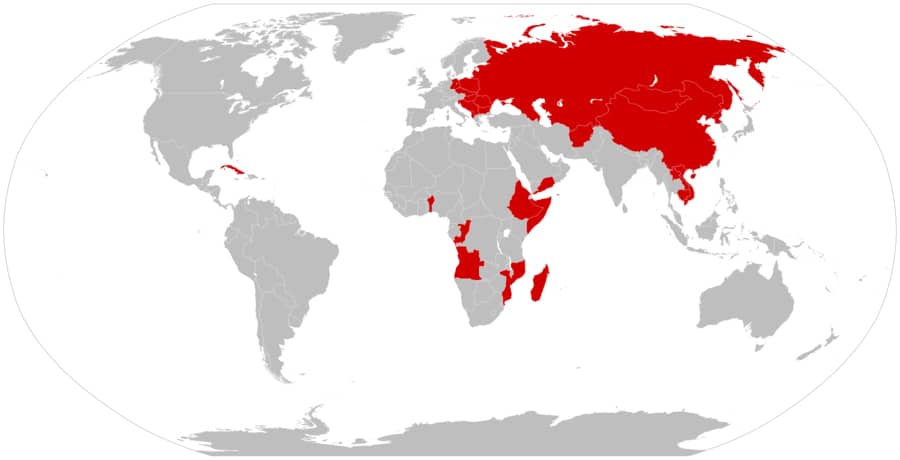
As a leader in Southeast Asian markets, Thailand has a history of supporting the U.S. fight for capitalism in the region dating back to the Cold War era.
Thailand is not communist and is ranked 21st out of 190 countries on the 2020 Ease of Doing Business Index. It is a mixed economy of capitalism with government regulation and control of strategic industries, similar to the United States.
Thai Constitutional Monarchy (similar to Britain) didn’t come into place until 1932, so the system of government hasn’t had much time to evolve from absolute monarchy. As democratic elections have been controversial, two recent coups have been staged by the armed forces in order to protect interests of the people from overreaching government control.
Is Thailand a Free Market Economy?
Thailand ranks among the easiest countries in the world to start a business (Ranked 21 in 2020 by the Ease of Doing Business Index created by leading economists at the World Bank Group).
Many sectors of the Thai economy are free to enter, but the government is responsible for decision making in several key sectors. Rubber, aviation, and rice are a few, but the government has also completely taken over companies in certain “strategic industries” that it deems necessary. Industries such as construction, transportation , and banking have been heavily controlled.
Some examples of industries where public backlash has caused serious government intervention include hydroelectric, logging, and financial industries.
Hydroelectric complexes were constructed in the 1980s and ultimately caused a lot of environmental issues. The complexes inundated large areas of forest, transformed flood patterns, and reduced the fish supply. Due to the impact, entire villages were displaced and mass demonstrations were held to protest the exploitation. As a result, the government became much more strict regarding approval of projects with environmental impact.
In 1989, the logging industry was banned following landslides believed to be caused by heavy deforesting. Prior to this, teak (hardwood) was a major export.
Following the 1997 crisis, fingers pointed to excess foreign investment. Various restrictions on foreign investment were implemented with an emphasis on self-reliance and moderation of consumption without rejecting capitalist investment. Policies implemented by Thaksin in the early 21st century were contrary to this type of ideology, but restrictions on foreign investment remain in many sectors.
A good example of this is that foreigners are not allowed to own land in Thailand under their name. Alternatives are available, such as developing a Thai Limited Company and owning the land in that way, however, there are restrictions to this option as a foreigner may not own more than 49% of the shares. Another loophole is that homes can be purchased without actually owning the land, but that requires leasing the land.
Thailand Economy
To understand the current state of the Thai economy, I’ll briefly walk-through how we arrived.
Thailand was under absolute monarchy until 1932 when a constitution and parliament were granted power. From this time until the Cold War era and shortly thereafter, the market was dependent on agriculture as the main export. This changed following a set of development plans initiated in 1963 to shift the country’s focus from agriculture to manufacturing.
From 1963-1997, Thailand was one of the fastest growing economies in the world with an open market and inflows of foreign investments. Compared to neighboring Myanmar, which was heavily self-reliant and socialist, it was majorly out-performing.
And then the 1997 economic crisis hit. The Thai Baht rapidly decrease in value followed by the collapse of the Thai Stock Exchange. Over-dependence on foreign investment and exports were major drivers for the collapse. Thai leadership during the crisis stepped down and members of the Democrat Party won the election.
As the Democrat Party followed advice and direction of the International Monetary Fund (IMF) for crisis resolution, major disagreements between Thai politicians and economists developed. Many argued the policies of the IMF at the time were based on experiments from African economies and were not reflective of Thailand’s current situation.
The Democrat Party lost following election and “Thaksinomics” went into effect. Thaksin Shinawatra was the Prime Minister elected in the 2001 election and his economic policy was based on heavy government intervention. He pressured the Bank of Thailand to flood money into the economy, pushed banks to offer low-interest loans, and took control of many companies in “strategic industries” along with increasing government regulation and control.
With his newfound control of construction and transportation companies, he pushed for “mega projects” to rapidly revamp the country’s infrastructure. In 2006, due to spiraling public debt along with massive backlash from his excessive government interference, the military stepped in and Thaksin was exiled.
Thaksin reportedly ordered export sectors, mainly rubber, to price gouge and drive prices up for western buyers. Thus giving Southeast Asia more power over commodities. In Thailand it is illegal to fix the prices of goods or manipulate markets.
In the following 2007 election, Thaksin’s former political party again won again under a new party name. As Thaksin was exiled, his sister was installed as the party’s leader in 2011 and continued implementing his policies until 2014. Another coup was staged by the military under leadership of Prayut Chan-o-chan to remove the party from power.
Leadership under Prayut Chan-o-chan has been hands-off in many economic regards, allowing the motions set in place by Thaksin’s administration to continue. “Thaksinomics” remain popular among the lower-class.
The recent 2019 general election again saw Thaksin’s political party continue to win majority seats. Positive aspects of the economic policies pushed by Thaksin and his party include restructured economic growth and stimulated consumer demand.
But this again comes at a cost; negative effects include increased government control, heavy public debt, and allegations of corruption.
Thailand Political Stability
While the political system in Thailand appears to be unstable from a analytical standpoint with many coups, the system is relatively new (established constitutional monarchy 1932) and functions with nationalistic intentions. If public safety is threatened, as it was deemed to be during 2006 and 2014, the military can and will interfere. The military re-wrote the constitution to make this legal.
But who interferes when the military wields too much power? Opposing political parties argue the military is disrupting civil liberties and the democratic process. Over the period of military control, military leaders were appointed to major political positions and have remained in those positions even after the 2019 election. However, the majority of the population still holds trust in the military as they have continued to allow the democratic process on multiple occasions following coups.
The constitution was redesigned in 2014 to give the military even greater powers if it deems the country is under crisis from a national security standpoint (including economic affairs).
What Are Thailand’s Political Parties?
There are basically three political parties that won major seats during the 2019 election. The Democrat Party is now widely viewed as a conduit for the Palang Pracharat (Military):
- Pheu Thai (Thaksin’s newly branded party as he still leads from exile)
- Palang Pracharat (Military party)
- Future Forward (pushing radical systematic change)
Why Is Thailand So Poor?
Thailand isn’t exactly poor, more so the wealth is unevenly distributed to rural areas. Major cities, such as Bangkok, hold a starkly uneven concentration of industrial and financial power.
Compared to western countries, Thailand may be viewed as poor, but in Southeast Asia it is one of the most successful countries. In terms of GDP, only Indonesia ranks higher.
Industrialization of Thailand did not truly occur until the 1970s-1980s, so the country is behind developed nations by a couple hundred years in that regard (American industrialization began in 1790). Even with the late start, Thailand performs well in terms of growth; specifically in tourism and manufacturing.
In the 1980s, agriculture accounted for 2/3 of exports. Now, agriculture only accounts for 1/8 exports and 1/10 of GDP. Manufacturing accounts for virtually all of the rest.
If you’re interested in reading more, I’ve gone into more detail about why Thailand is a developing country here.
